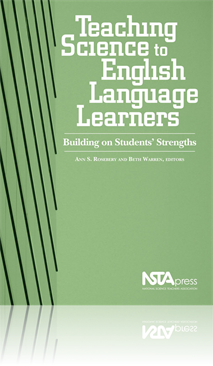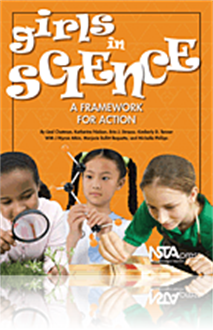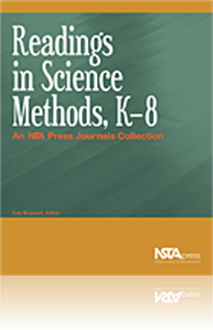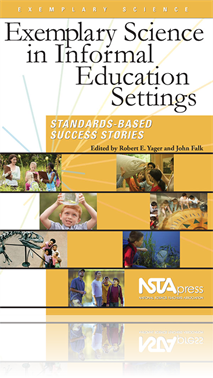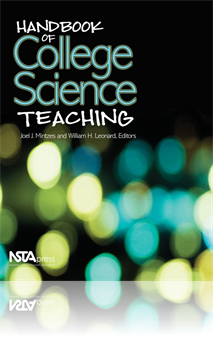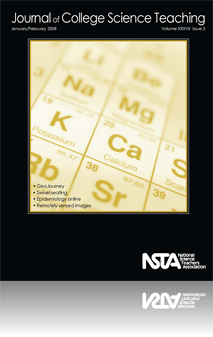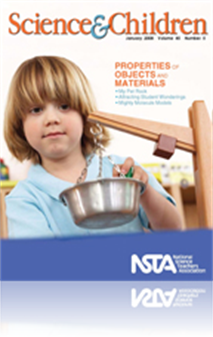All Resources
Book Chapter
What can a teacher do when she realizes that she has used an apparently simple word like think in a way that some students find strange? This happened in Suzanne Pothier’s classroom of first and second graders. She decided to take up the problem a...
Book Chapter
The Triad Story—A Science Education Community Navigating Gender Equity
In chapter 1, Triad and the Framework are described from a community perspective. In chapter 2, the authors describe how the Framework evolved from a more theoretical standpoint. They introduce its anatomy and initiate a more detailed discussion of i...
Book Chapter
The Nature of Science and Science Inquiry
In a knowledge-centered science classroom, students work to answer scientifically oriented questions by creating explanations based on evidence. This approach, called science inquiry, is how science is conducted. It creates a learning environment tha...
Book Chapter
Youth Leadership at The Franklin Institute: What Happened When the Grant Ran Out
The Franklin Institute's Center for Innovation in Science Learning develops model programs for the K-12 science education community, both inside and outside the Museum walls. This chapter profiles the Institute's Partnership for Achieving Careers in ...
Book Chapter
Science Career Ladder at the NY Hall of Science: Youth Facilitators as Agents of Inquiry
The New York Hall of Science is New York City’s hands-on science and technology center, with more than 400 interactive exhibits exploring physics, chemistry, and biology. The Hall also creates and presents demonstrations and programs for students a...
Book Chapter
A Burger, a Beer… and a Side of Science
Science Cafés are part of a unique national informal education outreach initiative for NOVA ScienceNow, a PBS science series. The project's special focus is to reach new audiences—both on air and off—especially those younger than traditional PBS...
Book Chapter
The Museum Institute for Teaching Science (MITS) promotes the teaching of participatory, hands-on and minds-on, inquiry-based science, technology, engineering, and mathematics (STEM) at the K-8 grade levels, through collaboration among informal scien...
Book Chapter
Discovery Center at Murfree Springs, a hands-on museum and environmental education center, has created a science tour for grades preK-2, called “Splash, Flash, Crank, Slide, Alive Tour,” which is based on the National Science Education Standards....
Book Chapter
Grands Are Grand is a monthly informal science program for children ages 3-5 and their grandparents offered by the North Museum of Natural History & Science in Lancaster, Pennsylvania. The lessons include a wide variety of touchable, visual, and aud...
Book Chapter
FAMILY MATH and Science Education: A Natural Attraction
The Lawrence Hall of Science is a resource center for science and mathematics education and a public science center with exciting hands-on experiences for learners of all ages. One of its programs, FAMILY MATH, is built on the belief that children c...
Book Chapter
Informal education venues, by their very definition, are predisposed to the successful implementation of the More Emphasis conditions of the National Science Educations Standards (NSES), and Mote Marine Laboratory is no exception to this trend. At Mo...
Book Chapter
The Body of Evidence: COSI’s In Depth: Autopsy Videoconference Program
The Center of Science and Industry’s (COSI) Electron Education program, In Depth: Autopsy, allows students to see and participate in an autopsy as much as possible, given the limits of videoconference technologies. The program puts anatomy, physiol...
Book Chapter
Citizen Science at the Cornell Lab of Ornithology
The Cornell Lab of Ornithology is an international center for the study, appreciation, and conservation of birds located on a 200-acre wildlife sanctuary in Ithaca, New York. Founded in 1915 by Arthur A. Allen, the world’s first professor of ornith...
Book Chapter
Can an Informal Science Institution Really Play the Key Role in K–12 Science Education Reform?
The Washington State LASER (Leadership Assistance for Science Education Reform) program is under the leadership of the Pacific Science Center, an informal, nonprofit science institution, dedicated to increasing the public’s understanding and apprec...
Book Chapter
Advancing the NSES Vision through Informal Science Education
Despite originally being almost exclusively focused on the school context, the National Science Education Standards (NSES) emerged as an amazingly relevant document for the informal context as well. All four of the Standards—Teaching Standards, Con...
Book Chapter
Inquiry Is Taking Flight Through Project Butterfly WINGS
Project Butterfly WINGS (Winning Investigative Network for Great Science) is designed to foster adolescents' interest, understanding, and long-term involvement in science, as well as promote positive youth development. Through WINGS, students form a ...
Book Chapter
Curious Scientific Investigators Solve Museum Mysteries
The Children's Museum of Indianapolis has developed the Curious Scientific Investigators (CSI) program, which mixes the best the Museum has to offer with classroom instruction. Therefore, CSI’s vision is to support learning by all members of a clas...
Book Chapter
The Ocean Institute (OI) is dedicated to increasing awareness and understanding of the ocean environment. Its 9-week Weather & Water program is intended to interface the very frontier of ocean science with the needs of fifth-grade teachers and classr...
Book Chapter
Omaha’s Henry Doorly Zoo Academy: Where Science Education Comes to Life!
Omaha's Henry Doorly Zoo has become a leader in both informal and formal science education. Its Zoo Academy is one example of an effective nontraditional teaching model for science education. The academy has become an excellent work-based learning mo...
Book Chapter
Alternative Conceptions: New Directions and Exemplars in College Science Education Research
The most useful science education research for college science teachers is theory based and includes data collected from studies with college students, along with a discussion of the implications for teaching. In this chapter, the authors use example...
Journal Article
Integrating a Single Tablet PC in Chemistry, Engineering, and Physics Courses
A tablet PC is a versatile computer that combines the computing power of a notebook with the pen functionality of a PDA (Cox and Rogers 2005b). The authors adopted tablet PC technology in order to improve the process and product of the lecture format...
Journal Article
GeoJourney is an interdisciplinary field trip in geology, Native American studies, and environmental studies designed for introductory-level undergraduates. The program travels 23,345 kilometers by van to national parks, industrial sites, museums, an...
Journal Article
This month, Mercury will start becoming visible over the western horizon shortly after sunset. If you have students observe Mercury, they should do so at approximately the same time for each observation. During the first half of the month, Mercury wi...
eBook
Teaching Science to English Language Learners: Building on Students’ Strengths (e-book)
Can a student’s cultural background support learning in science? Or is concentrating on the specialized vocabulary of science the best way to help English language learners learn science? This book addresses these and other pressing questions you ...
Journal Article
Sponsored by NASA and the JASON Education Foundation, the remote Sensing Earth Science Teacher Education Program (RSESTeP) trains teachers to use state-of-the art remote-sensing technology with the idea that participants bring back what they learn an...
Journal Article
Editor’s Corner: Earth in the Balance
The study of Earth science is sometimes overlooked in our high school science curriculums. In the rush to get through the sequence of biology-chemistry-physics and on to advanced level or AP courses, students and their parents sometimes regard Earth ...
Journal Article
Speaker Perceptions of Communicative Effectiveness: Conversational Analysis of Student-Teacher Talk
This study examines verbal behavior in student-teacher talk and alignment of perceptions of communication effectiveness. Heightened awareness of conversational patterns is more productive in the learning environment than the rote use of discourse mar...
Journal Article
Teaching Earth Science Using Hot Air Balloons
Constructing model hot air balloons is an activity that captures the imaginations of students, enabling teachers to present required content to minds that are open to receive it. Additionally, there are few activities that lend themselves to integrat...



